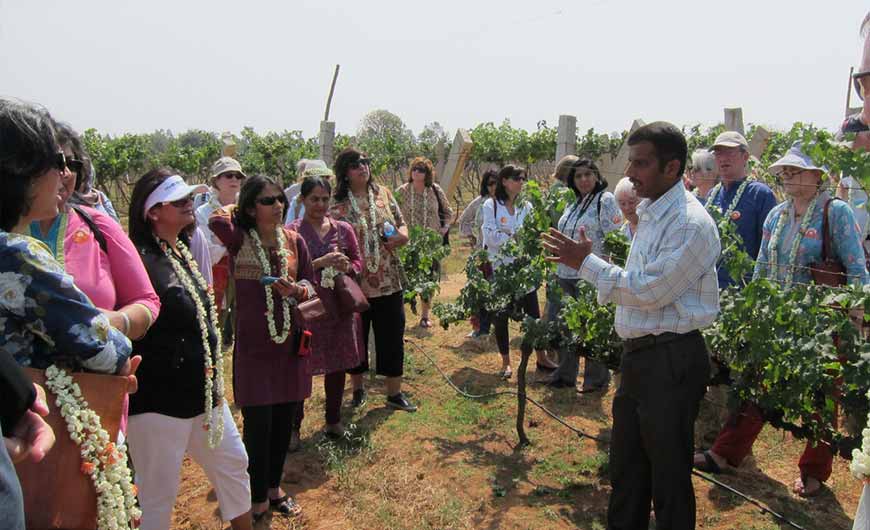India’s wine tourism industry is experiencing an unprecedented transformation, evolving from a niche luxury segment to a mainstream economic powerhouse. The global wine tourism market is projected to grow from USD 108.3 billion in 2025 to USD 358.6 billion by 2035, with India emerging as a significant player in this lucrative sector. What was once considered an elite indulgence has now become a driving force for rural development, cultural preservation, and economic growth across the subcontinent. With regions like Nashik, Pune, and Karnataka leading the charge, India’s wine tourism industry is not just about grape cultivation—it’s about creating immersive experiences that blend tradition with modernity, sustainability with profitability, and local heritage with global appeal.
The Economic Impact of Wine Tourism in India
India’s wine tourism sector is generating substantial economic benefits across multiple regions. Nashik’s wine tourism industry alone generates approximately ₹1,000 crores (around $130 million) annually and supports over 10,000 jobs. This remarkable figure demonstrates the sector’s capacity to drive significant economic growth in rural areas.
The economic ripple effects extend beyond direct wine sales. Wine tourism can increase local GDP by up to 8-10% in wine-producing regions, with tourists spending not only at wineries but also benefiting local restaurants, hotels, and transportation services. In Pune, the wine tourism sector contributes around ₹500 crores (approximately $65 million) to the local economy, while Karnataka’s wine tourism industry supports around 5,000 jobs across the region.
The sector’s potential is further highlighted by estimates suggesting that wine tourism could account for up to 15-20% of total wine sales in emerging markets. As India’s wine market is projected to reach USD 892.0 million by 2033, exhibiting a CAGR of 16.30%, the tourism component represents a significant growth opportunity.
Key Wine Tourism Destinations Across India

Maharashtra stands as India’s undisputed wine capital, with Nashik earning the nickname “India’s Napa Valley” for its picturesque vineyards set against the Western Ghats. The region hosts 70% of India’s vineyards and benefits from ideal climatic conditions for viticulture. Sula Vineyards and Vallee de Vin Vineyards serve as the primary hotspots for wine tourism, offering comprehensive experiences from tastings to festivals.
Karnataka, particularly around Bangalore and the Nandi Hills, has emerged as another significant wine tourism destination. The state’s wine tourism industry attracts thousands of visitors annually, contributing substantially to local economies while supporting employment across the hospitality and service sectors.
Pune has developed into an emerging wine tourism hub, with several wineries offering sophisticated tours and tastings that appeal to both domestic and international visitors. The region’s proximity to major urban centers makes it particularly attractive for weekend wine tourism experiences.
Sustainable Practices and Cultural Preservation
Modern Indian wine tourism emphasizes sustainability and eco-conscious practices. Many wineries are adopting organic farming, water conservation, and biodiversity preservation methods to attract environmentally aware travelers. This focus on sustainability aligns with global trends and India’s broader goals of promoting responsible tourism.
Wine tourism also supports cultural heritage preservation by promoting local traditions, architecture, and cultural identity. This includes preserving traditional winemaking practices and promoting local cuisines that pair with Indian wines, thereby enriching the culture.
Future Growth Prospects and Market Trends
The future of India’s wine tourism looks exceptionally promising. The culinary tourism market in Western India, which includes vineyard tours, is projected to grow at a 22.8% CAGR through 2035. This growth is driven by millennials and urban professionals seeking immersive experiences like wine tastings and farm-to-table dining.
Government initiatives are playing a crucial role in promoting India as a wine destination through organized wine festivals, wine trails, and educational programs. These efforts are enhancing the global perception of Indian wines and positioning the country as an emerging player in international wine tourism.
The integration of technology and e-commerce is also expanding wine tourism accessibility, with online platforms making it easier for tourists to discover and book wine experiences across different regions.


